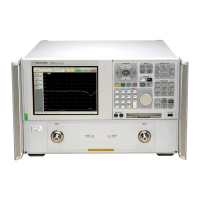Service Guide E8364-90026 8-13
PNA Series Microwave Network Analyzers General Purpose Maintenance Procedures
E8362B, E8363B, E8364B Error Terms
Reflection Tracking (E
RF
and E
RR
)
Reflection tracking is the difference between the frequency response of the reference path
(R1 or R2path) and the frequency response of the reflection test path (A or B input path).
These error terms are characterized by measuring the reflection (S
11
, S
22
) of the open and
the short during the measurement calibration.
All reflection measurements are affected by the reflection tracking errors.
Typical Cause of Failure The calibration kit open or short is the most common cause of
reflection tracking specification failure.
If the open or short performance has been independently verified, suspect the following:
• If both E
RF
and E
RR
fail
— suspect the analyzer switch splitter
• If one of the track term specification fails
— suspect the coupler, step attenuator, or the test receiver of the failed port
To troubleshoot, refer to “Checking the Receiver Group” on page 4-52 or to “Checking the
Signal Separation Group” on page 4-48.
Transmission Tracking (E
TF
and E
TR
)
Transmission tracking is the difference between the frequency response of the reference
path (including the R input) and the frequency response of the transmission test path
(including the A or B input) while measuring transmission. The response of the test port
cables is included. These terms are characterized by measuring the transmission (S
21
, S
12
)
of the “thru” configuration during the measurement calibration.
All transmission measurements are affected by transmission tracking errors.
Typical Cause of Failure The test port cable is the most common cause of transmission
tracking specification failure.
If the test port cable performance has been independently verified, suspect the following:
• If both E
TF
and E
TR
fail
— suspect the analyzer switch splitter
• If one of the track term specification fails
— suspect the coupler, step attenuator, or the test receiver of the failed port
To troubleshoot, refer to “Checking the Receiver Group” on page 4-52 or to “Checking the
Signal Separation Group” on page 4-48.

